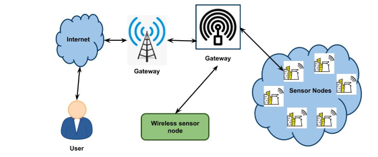Internet Traffic Dynamics in Wireless Sensor Networks Based on Energy Efficiency with Routing Protocols
Keywords:
Wireless Sensor Network, Internet Traffic Dynamics, Energy Efficient, Routing, ClusteringAbstract
Wireless sensor network (WSN) has emerged as a promising technology for the recent advances in electronics, networking, and information technologies. This dissertation offers multiple methods for modelling various elements of WSN traffic in the area of traffic analysis and modelling for WSNs. This research proposed novel technique in analysing the internet traffic dynamics of WSN by energy efficient and routing of the network. Here the traffic analysis is carried out using dynamic distance vector protocol and the routing is enhanced with energy efficiency using clustering based lightweight spatio energy efficient routing technique. The experimental analysis has been carried out in terms of throughput, traffic analysis, energy efficiency, packet delivery ratio.
Downloads
References
Faheem, M., Butt, R. A., Raza, B., Alquhayz, H., Ashraf, M. W., Raza, S., &Ngadi, M. A. B. (2020). FFRP: dynamic firefly mating optimization inspired energy efficient routing protocol for internet of underwater wireless sensor networks. IEEE Access, 8, 39587-39604.
Hosahalli, D., & Srinivas, K. G. (2020). Enhanced reinforcement learning assisted dynamic power management model for internet‐of‐things centric wireless sensor network. IET Communications, 14(21), 3748-3760.
Gupta, S. K., & Singh, S. (2022). Survey on energy efficient dynamic sink optimum routing for wireless sensor network and communication technologies. International Journal of Communication Systems, e5194.
Dogra, R., Rani, S., Sharma, B., Verma, S., Anand, D., & Chatterjee, P. (2021). A novel dynamic clustering approach for energy hole mitigation in Internet of Things‐based wireless sensor network. International Journal of Communication Systems, 34(9), e4806.
Dwivedi, A. K., Mehra, P. S., Pal, O., Doja, M. N., &Alam, B. (2021). EETSP: Energy‐efficient two‐stage routing protocol for wireless sensor network‐assisted Internet of Things. International Journal of Communication Systems, 34(17), e4965.
Shyjith, M. B., Maheswaran, C. P., & Reshma, V. K. (2021). Optimized and dynamic selection of cluster head using energy efficient routing protocol in WSN. Wireless Personal Communications, 116(1), 577-599.
Nasri, M., Lamiri, A., Maaref, H., &Mghaieth, R. (2022). Adaptive dynamic multi‐hop technique for clustering protocol in wireless sensor networks assisted‐Internet of Things applications. IET Networks, 11(1), 27-41.
Kavitha, V. (2021). Privacy preserving using multi-hop dynamic clustering routing protocol and elliptic curve cryptosystem for WSN in IoT environment. Peer-to-Peer Networking and Applications, 14(2), 821-836.
Sarad, A., Verma, A., &Badholia, A. An Approach providing Congestion Control & Avoidance using Priority based Energy Efficient mechanism for Internet of Things (IoT).
Amutha, R., Sivasankari, G. G., Venugopal, K. R., & Stephan, T. (2022). DTAR: A Dynamic Threshold Adaptive Ranking-Based Energy-Efficient Routing Algorithm for WSNs. Journal of Interconnection Networks, 2149001.
Chéour, R., Jmal, M. W., Khriji, S., El Houssaini, D., Trigona, C., Abid, M., &Kanoun, O. (2021). Towards Hybrid Energy-Efficient Power Management in Wireless Sensor Networks. Sensors, 22(1), 301.
Yun, W. K., &Yoo, S. J. (2021). Q-learning-based data-aggregation-aware energy-efficient routing protocol for wireless sensor networks. IEEE Access, 9, 10737-10750.

Downloads
Published
How to Cite
Issue
Section
License
Copyright (c) 2022 Manu Singh, Vanitha K., Bhargabjyoti Saikia, Arpana Mishra, Sameeksha Verma, Sachin Gupta

This work is licensed under a Creative Commons Attribution-ShareAlike 4.0 International License.
All papers should be submitted electronically. All submitted manuscripts must be original work that is not under submission at another journal or under consideration for publication in another form, such as a monograph or chapter of a book. Authors of submitted papers are obligated not to submit their paper for publication elsewhere until an editorial decision is rendered on their submission. Further, authors of accepted papers are prohibited from publishing the results in other publications that appear before the paper is published in the Journal unless they receive approval for doing so from the Editor-In-Chief.
IJISAE open access articles are licensed under a Creative Commons Attribution-ShareAlike 4.0 International License. This license lets the audience to give appropriate credit, provide a link to the license, and indicate if changes were made and if they remix, transform, or build upon the material, they must distribute contributions under the same license as the original.





